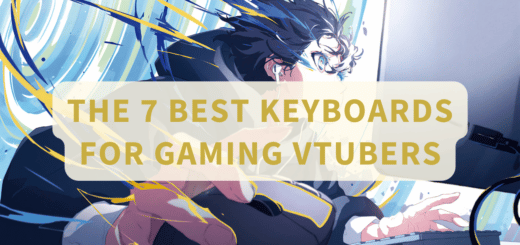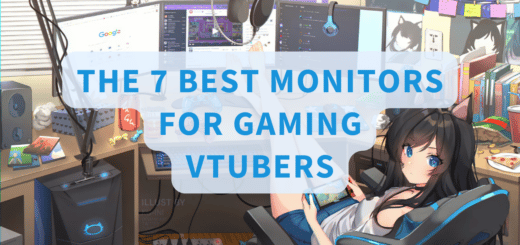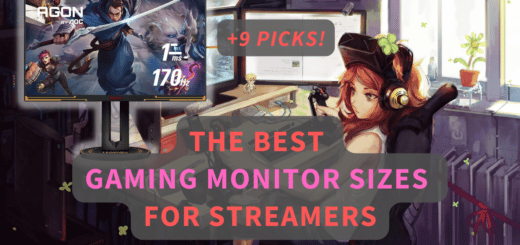The 6 Best Cameras For VTubers (IRL Streaming)
When you’re getting into the content game, your video quality is what matters most for your channel’s success. But the camera market is just so confusing, filled with a gazillion models, features, brands, price tags—you name it. Navigating through this wild territory to find the perfect one can be a real head-scratcher.
If you don’t want to read further, here’s the crux of this article: The Sony Alpha 6700 comes out on top as the best camera for streaming. It’s super versatile and has pro-level controls for enthusiasts. But if you want a budget-friendly, easy-to-use camera, the Nikon Z30 is a great option.
If you are only going to be VTubing and stay behind your VTuber model, you don’t have to worry about any of these things (any of the VTuber cameras mentioned in the previous article will do just fine).
But if you are planning on those IRL streams along with VTubing, you’ll have to think about all these factors—your regular webcam won’t cut it.
I mean, to create a parasocial relationship that you are hoping to build with your viewers, they need to know what you look like (or, at least, what your surroundings look like). Right?
Don’t stress, though; we’ve got your six! We’ve scoured every nook and cranny to serve up the ultimate list of cameras that’ll level up your content creation game, making your life easier so you can hit record ASAP!
And guess what? We’re spilling the deets on the hottest cameras loved by YouTube film maestros and A-list streamers. Keep scrolling to check out your options and snag some pro tips for whipping up top-tier video content.
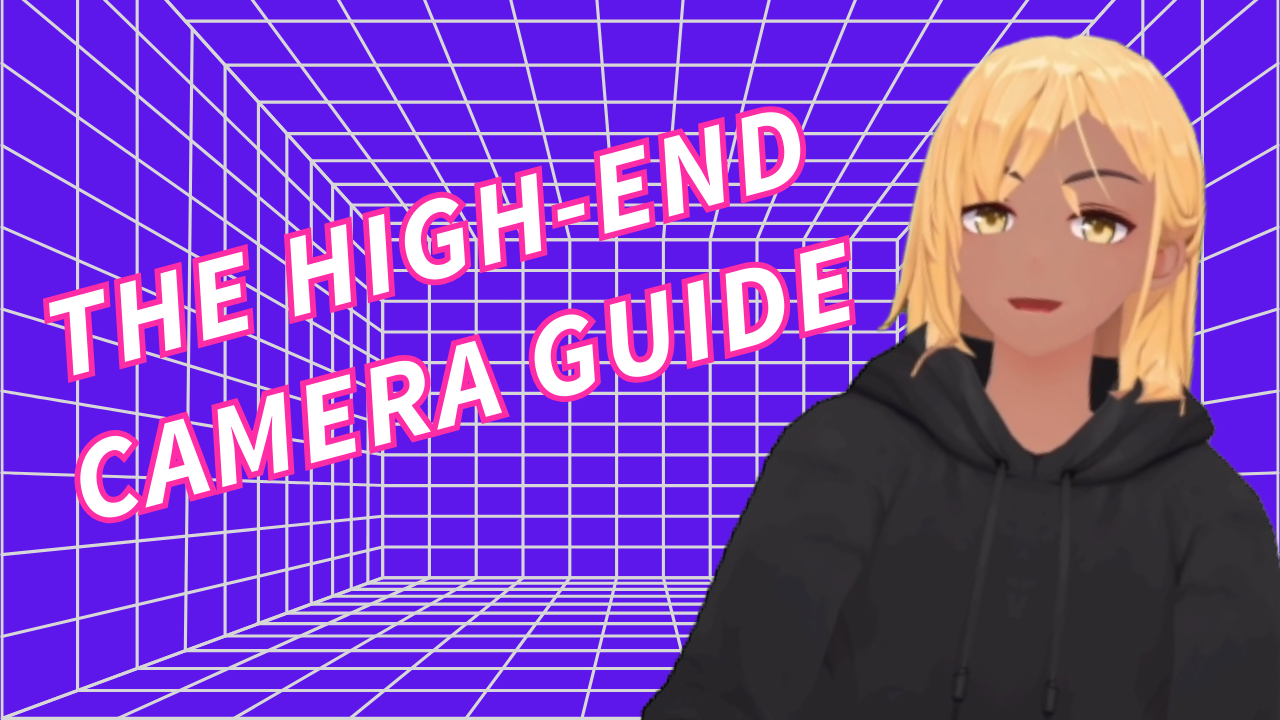
Table of contents
- Best Cameras For VTubers
- The Sony A7 III Mirrorless Camera: Most Popular Camera Among Streamers
- Canon EOS R: The Best Vlogging Camera From Canon
- Sony NEW Alpha 7S III: Best Camera For Cinematic Shots (Professional Level Camera)
- Sony ZV-1 II: The Best Camera For IRL Travel Vlogging (Super Compact)
- Sony Alpha 6700: The Best Camera Overall
- Nikon Z30: Best Budget Vlogging Camera From Nikon
- The Only 2 Lenses You’ll Need With A Sony Camera
- Wrapping Up: What To Look For In A Streaming Camera
Best Cameras For VTubers
- The Sony A7 III Mirrorless Camera: 🥇 Most Popular Camera Among Streamers
- Canon EOS R: 🥇 The Best Vlogging Camera From Canon
- Sony NEW Alpha 7S III: 🥇 Best Camera For Cinematic Shots (Professional Level Camera)
- Sony ZV-1 II: 🥇 The Best Camera For IRL Travel Vlogging (Super Compact)
- Sony Alpha 6700: 🥇 The Best Camera Overall
- Nikon Z30: 🥇 Best Budget Vlogging Camera From Nikon
The Sony A7 III Mirrorless Camera: Most Popular Camera Among Streamers

I’ve been rocking the Sony a7C for a solid year now, and let me tell you, it’s been great for my content grind. Whether I’m dropping videos on YouTube, capturing my bro’s wedding, or hustling on work projects, the a7C’s been my go-to.
Straight up, the a7C’s 4K files are great. Colors pop, and they fixed the magenta mess from the A7 III. The 6K downsampled 4K is so crispy, it might not be everyone’s vibe, but for tech content like mine, it’s on point.
Sony’s autofocus is flexin’ hard in the a7C. Eye tracking and object tracking are on another level (so, if you want to use it as your primary VTubing camera, you can do so with no worries). No more stressing about focus—just point, shoot, and slay.
When the lights go low, the a7C holds it down, especially with low dynamic range profiles. Pump that ISO, and you’re still shining bright.
SLOG 3 for that HDR magic, but watch out for the 8-bit color limit. If you’re into heavy grades, tread carefully. But for me, keeping it natural, it’s fantastic.
Crop mode is incredible, especially for my prime lenses. Extra reach without swapping glass? Yes, please. A fully articulating screen is clutch for those high and low angles, perfect for IRL vlogs. It makes life easy.
Battery life is insane, and the a7C doesn’t pull that 30-minute record-limit nonsense. No overheating drama either—solid even under the summer sun. The headphones and mic jacks are in the right spots. So, editing is smooth as butter on my M1 Mac Mini.
Missing separate settings for photo and video sucks, but Sony dropped firmware 2.00, turning the a7C into a plug-and-play webcam.
Canon EOS R: The Best Vlogging Camera From Canon
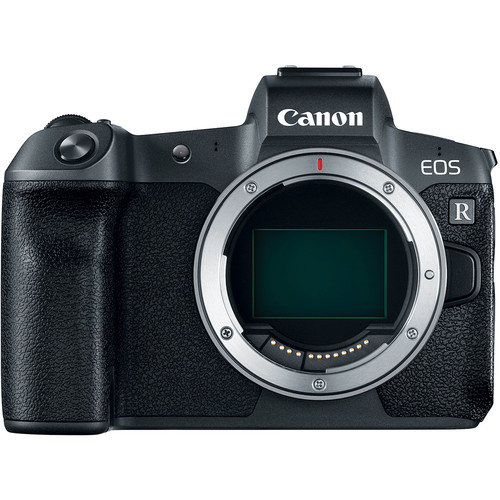
The Canon EOS R might just be the tool you’re looking for. Sure, the 4K mode has a 1.8x crop, but no worries—you can still use your favorite EF or EF-S lenses with an adapter, like the 10–18mm or 17–55mm f/2.8 for those wide shots.
The EOS R is making waves as a top Canon vlogging camera. Consider picking up the 10–18mm or 17–55mm f/2.8 for stabilized footage. Two extra stabilization modes? Yup, it’s practically vlogging in easy mode, and the SwitchPod becomes your trusty sidekick.
Activate Canon Log and enjoy 12 stops of dynamic range for cinematic vibes—it’s like having a mini C200! You can even film in 10-bit with an Atomos Ninja V. Handy features like focus peaking and guides, along with reliable continuous autofocus, give your videos a professional touch. The 3.7 million-dot electronic viewfinder? A lifesaver when it’s too bright for the LCD.
The EOS R lets you shoot at 120 fps in 720p, and surprisingly, it looks great thanks to a 160 Mbps bitrate. Even compared to 1080p slow-mo from other brands, it holds its own, even when upscaled to 4K.
Exciting news for lens lovers: the new $500 35mm RF lens brings macro focus abilities, image stabilization, and a lighter weight to your setup, perfect for video shooting.
Now, it’s not all perfect, though. Switching modes is a bit slow, the record button could be more user-friendly (consider remapping it to the shutter), and there’s no “true” in-body stabilization. Also, watch out for that rolling shutter in 4K mode.
Sony NEW Alpha 7S III: Best Camera For Cinematic Shots (Professional Level Camera)
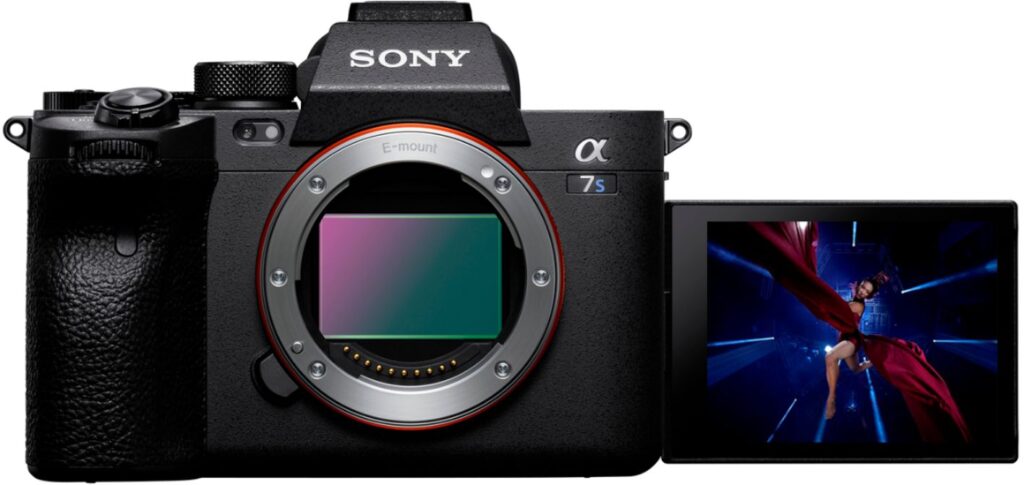
This sick, full-frame, mirrorless beast is about to level up your content game! The A7S III offers UHD 4K quality and is all about that laser focus on video awesomeness. Imagine rocking those low-light scenes like a boss—this bad boy shines in the dark, perfect for those moody shots and nighttime adventures.
Worried about running out of juice? No stress with this powerhouse! It’s got the stamina to keep up with your content creation marathons. Navigating settings is super easy with the user-friendly touchscreen, adding some swagger to your workflow.
Yeah, every hero’s got its challenges. The A7S III leans towards the premium side in terms of the price tag, but if you’re hungry for top-tier content, it’s a solid investment.
We’re talking a 35mm full-frame Exmor R CMOS sensor, lightning-fast hybrid autofocus with 759 phase-detection AF points, and a fully articulating 3″ LCD touch panel. The dual UHS-II SD/CFexpress Type A slots make this camera a double-edged sword in the field.
When this baby’s in action, it’s a cinematographer’s dream. The magnesium alloy construction, solid grip, and fully articulating screen make handling a pleasure. Customizable autofocus with 759 phase-detection AF points opens up a world of possibilities for nailing that perfect shot.
Video creators, get ready for a treat with 4K 120p support, 10-bit 4:2:2 recording, and killer image stabilization, promising those smooth cinematic vibes even in challenging conditions.
Powering this creative beast are Z-series batteries, delivering impressive performance. Fast charging through the USB-C port ensures minimal downtime, keeping you locked and loaded for the next epic shot.
If video dominance and low-light excellence top your wishlist, the Sony A7S III is your ticket to content creation supremacy.
Sony ZV-1 II: The Best Camera For IRL Travel Vlogging (Super Compact)

This camera is a slick, responsive hybrid that slides right into your pocket, becoming your sidekick for everyday adventures. This ‘all-in-one’ wonder is your go-to for both killer photos and epic videos.
The wider zoom lens steals the show, perfect for breathtaking landscapes and vlogging, so you can pack more into every shot. The touchscreen gets a facelift, giving smartphone users an even smoother experience.
Sure, the ZV-1 II sticks with the same sensor and processor as its predecessor, but don’t be fooled—it’s a pint-sized powerhouse, tailor-made for on-the-go content creators and vloggers.
Some might miss the headphone jack and USB-C cable, but the upgraded touchscreen and flexible microphone more than make up for it. This camera doesn’t mess with a winning formula; it refines and amps up the game, following the ‘if it ain’t broke, don’t fix it’ mantra.
Pros like the versatile touchscreen and an ultra-wide 18mm optical zoom stand out, and the new Cinematic Vlog settings add a dash of flair to your visuals.
The 20.1MP Exmor RS CMOS sensor and 4K video at 30fps keep the ZV-1’s rep high. Design-wise, it’s compact and portable, slipping into jacket pockets like a charm. Sure, it misses an eye-level viewfinder, but the ZV-1 II makes up for it with its sleek form factor.
Battery life clocks in at around 45 minutes, and while the absence of a mains adapter or USB-C cable might raise an eyebrow, once juiced up, it delivers the goods.
If you’re a content creator ready to level up with improved features and a camera that fits in your pocket, this camera is calling your name.
Sony Alpha 6700: The Best Camera Overall
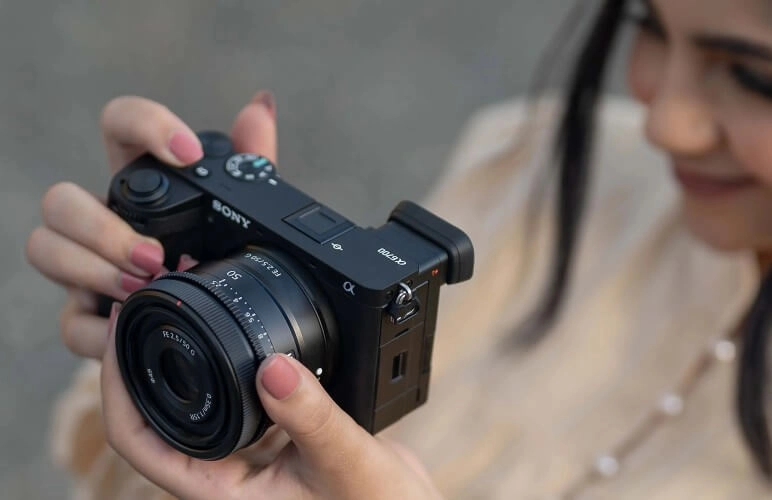
The Sony A6700 is the freshest addition to the APS-C mirrorless crew, throwing down for both photo fanatics and video wizards. With a 26MP BSI CMOS sensor, a Bionz XR processor, and an ‘AI Processing Engine,’ this cam is a speed demon, hitting 11 fps shooting.
It’s packing dual command dials, a first in the a6x00 series, for next-level control. Crafted from magnesium alloy, the redesigned body brings that sleek vibe and good environmental sealing.
The A6700 steps up with a fully articulated rear LCD panel and 4K up to 60p from 6K capture, pushing the boundaries of video creativity. S-Cinetone, S-Log3, and HLG profiles, along with customizable LUTs, turn it into a visual feast. Auto Framing from the ZV-E1 spices things up, automating subject tracking and framing for those pro-level shots.
We’re talking 2.36M dot OLED goodness with a refresh rate of up to 120fps, paired with a swanky 1.04M dot touchscreen. The trusty NP-FZ100 battery is powering this powerhouse, giving you over 500 shots per charge. USB-C takes the spotlight, delivering power and data at warp speed.
The A6700 flexes revamped menus for an intuitive journey. No AF joystick? No problem—we got a touchscreen-turned-‘AF touchpad’. And with a single UHS-II SD card slot, it’s all about those swift V90 cards for seamless video capture.
The A6700 is a beast in the video world, hitting 4K/120p, has killer rolling shutter stats, and offers a buffet of video options. Autofocus is on point, tracking subjects like a pro. Face and eye detection? Top-notch. Animal detection? Nails it.
The Sony a6700 is the cool kid on the block, blending sleek design, advanced features, and creative firepower for your visual adventures.
Nikon Z30: Best Budget Vlogging Camera From Nikon
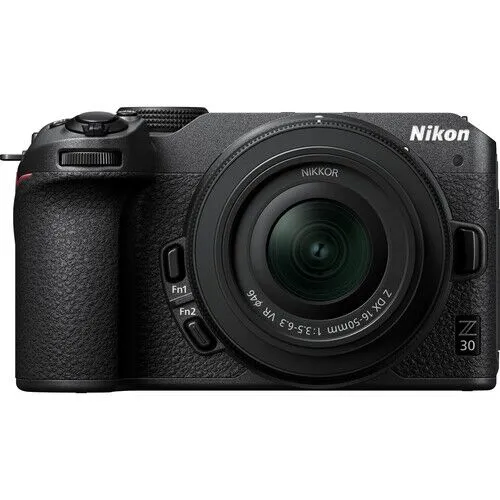
The Nikon Z30 is the freshest 20.2MP APS-C mirrorless cam flexing for content creators ready to ditch their smartphones. It’s a vlogging beast, rocking that 4K/30p magic, 1080p at 120fps for those epic slow-mo shots, and a slick 2-hour USB-powered video spree. It has a 3.0″, 1.04M dot touchscreen, a lit REC button, and a tally lamp for that extra flair.
The solo Z30 hits $696; slap on the collapsible 16-50mm F3.5-6.3 VR lens, and you’re at $830. Feeling bougie? The dual-lens setup with the 50-250mm F4.5-6.3 VR is $1149.95. And there’s a ‘Creators Accessory Kit‘ dropping at $946, with two lenses.
Who’s this bad boy for? Vloggers and video creators who crave that 4K/30p mojo, all packed in a compact size with vlogging perks. It won’t outshine top-tier cameras, but the Z30’s flip-around screen, custom controls, and mic game make it a run-and-gun star. A selfie master for the social media wizards.
It slays in the vlogging arena. Fully articulating screen? Check. Big record button? Check. Tally lamp? Double-check. Handling? Smooth as butter. Customizable dials? Front and rear, baby. UHS-I SD card slot? Easy access, even with a tripod.
Vlogging isn’t just about the shoot; it’s the post-production, too. Nikon gets it with the ‘Flat’ color profile—post-production without the Log profile headache. Match your video vibes with stills effortlessly.
Z30 rolls with the trusty 20.2MP sensor, serving sharpness in the daylight and low-light resilience. It isn’t groundbreaking, but it’s a solid player.
The Z30 is a compact dynamo for the chill vlogger. No wild features, but for $710, it’s your sidekick for the vlogging adventures.
The Only 2 Lenses You’ll Need With A Sony Camera
Here’s the breakdown of my go-to lenses for vlogging on Sony full-frame cameras:
Tamron 17-28mm f/2.8:
- Size and Weight: Smaller, lighter, and more budget-friendly compared to the Sony 16-35mm. You’re only losing one millimeter in width, and the difference in reach isn’t a deal-breaker.
- Constant Aperture: That f/2.8 aperture stays constant from 17 to 28mm, giving us consistent low-light performance and bokehlicious shots.
Sony 20mm f/1.8:
- Solo Vlog: When flying solo and craving that cinematic, wide-angle look, the Sony 20mm f/1.8 is the move. Perfect for creating those mesmerizing vlogs.
- Low-Light Performance: With that sweet f/1.8, you’re capturing dreamy shots in low light. Ideal for those breathtaking solo adventures.
- Price Tag Harmony: Both lenses are in the same ballpark price-wise, but this Sony gem comes in just a Benjamin more. A small investment for that solo vlog aesthetic.
Wrapping Up: What To Look For In A Streaming Camera
Choosing the perfect vlogging camera is no joke, and in this section, we’ll discuss some features you shouldn’t overlook. First off, snag a camera with a fully articulated screen; it’s a solo setup lifesaver, making sure you nail that shot composition every time.
Also, make sure your camera has extended screen connectivity, letting you project your view onto a bigger screen for detailed monitoring. HDMI output or the trendy USB-C usually handles this. Keep the focus sharp with continuous autofocus while recording video—a must for those on-the-move shots.
Say goodbye to focus mishaps in busy backgrounds by choosing a camera with focus priority through face recognition. Save your face—literally—so the camera prioritizes you over any distractions. Touch-to-focus is another gem, making it super easy to adjust the focus with a simple tap on the live view touchscreen.
Amp up your audio game by picking up a camera with an external microphone jack and a hot/cold shoe. This combo lets you seamlessly upgrade your vlog’s sound quality. Weight matters, especially for handheld vlogging; anything heavier than 1.54 lb (700 g) for a DSLR setup might test your endurance.
Fight off shaky footage with optical image stabilization (OIS), an awesome feature for those on-the-go shots. Check the battery life for those long vlogging days; while extra batteries are an option, a camera with good battery life is a solid plus.
And don’t forget 4K resolution video recording—a bonus for post-production flexibility, especially for zooming and close-ups without sacrificing quality.
As per these standards, the Sony Alpha 6700 comes out on top as the best camera for streaming. It’s super versatile and has pro-level controls for enthusiasts. But if you want a budget-friendly, easy-to-use camera, the Nikon Z30 is a great option.
That’s all, folks!
